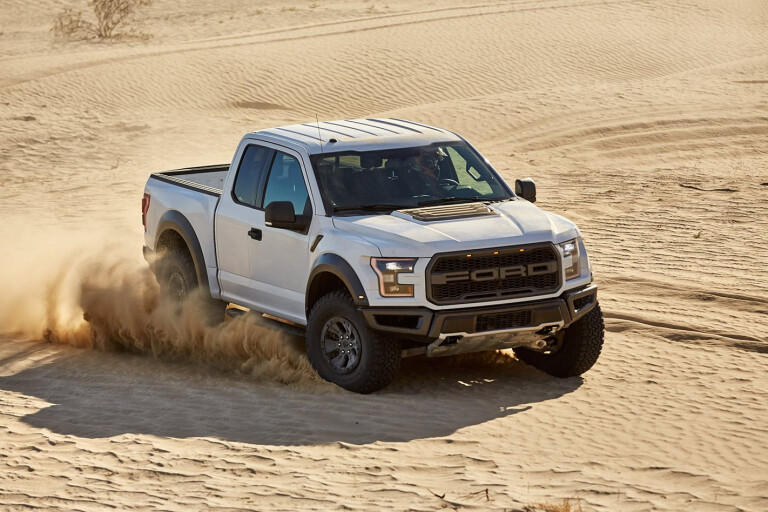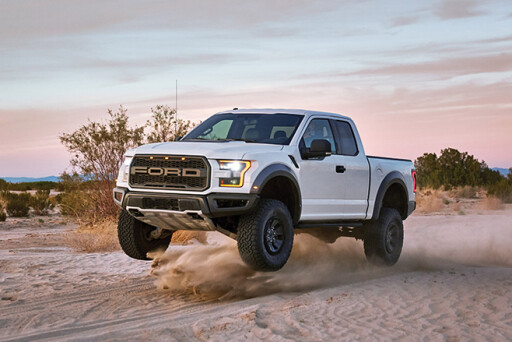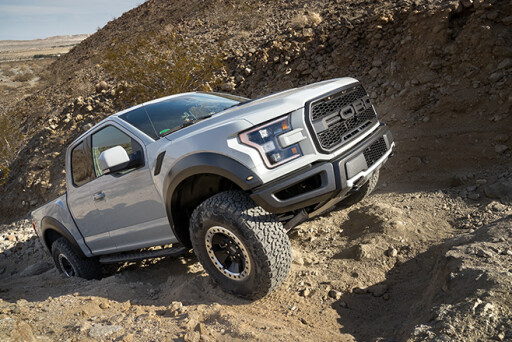
THE Ford F-150 Raptor is an everyday pick-up truck turned desert racing machine.
Initially launched in 2010 on the previous generation chassis, we haven’t seen a Raptor since 2014. The all-new 2017 model is based on the significantly lighter, current-generation aluminium F-150. It’s up on performance, equipped with improved and virtually unmatched suspension, and it’s stuffed with enough technology for you to pretend you’re running the Baja 1000.
WHO IS IT FOR?
THE new Ford 2017 Raptor is one of the world’s most capable off-road vehicles, coming with factory-engineered options that would cost thousands to match with aftermarket parts.
For example, it would cost tens-of-thousands of dollars to make a new 4Runner or Tacoma match the 2017 Raptor’s stock level of performance, just in the suspension department. We won’t even get into the calamity-inducing power under the Raptor’s hood, and then there’s the fact that this goes down the highway without a single squeak, rattle, or worry – all with a warranty.

It also plays daily-driver duty better than most other off-road vehicles we’ve driven, with the advanced suspension giving it a high-end ride, and the fuel-efficient, all-new aluminium 3.5-litre EcoBoost returning acceptable fuel-usage figures – Ford rates it at 15L/100km. For a vehicle fitted with 35-inch tyres and a lift, that is an impressive figure. It’ll tow your trailers with ease and ensure that, no matter if the roads are snowed shut, you’ll get there.
DESIGN
IT might be based on a production F-150, but the Raptor features more than 400 changes from the standard truck. Ford didn’t cut corners, even being so specific as to re-route all of the brake and ABS lines thanks to the increased wheel travel and the dual exhaust. The new model has a tweaked frame to allow for more suspension travel.
Insane 6X6 VelociRaptor from Hennessey
It’s available in two different configurations, SuperCab and SuperCrew, both offering four doors, with only the latter having a dedicated door for the rear passengers. Most will opt for the SuperCrew and its longer wheelbase, though the SuperCab’s 3409mm wheelbase will be more agile off-road while still offering room for the occasional passenger. While both share the same driveline, the SuperCrew, with its 3708mm wheelbase, can tow up to 3629kg, 2000kg more than its smaller variant. Payload with either model isn’t terribly impressive, at 454kg (SuperCab) and 544kg (SuperCrew).
The 3.5-litre EcoBoost engine, putting out 331kW and 691Nm, shares nothing with the previous-gen engine, except that they’re both 3.5 litres and a V6. Ford’s done a great job with this motor; it is responsive and has almost no perceivable turbo-lag. It’s also lighter than the cast-iron brick it replaces.

When paired with the all-new 10-speed transmission, this engine becomes savage. It’ll skip gears when needed to keep it calm around town, but once it enters Sport mode it becomes fierce and aggressive. Ten gears seems preposterous, but it’s one of the reasons the Raptor is always in the power band and ready to attack.
Three-inch diameter, nine-stage, internal bypass shocks from Fox Racing ensure the Raptor is turned into something more than a mere pick-up truck. When combined with the healthy amount of power it has, this is the closest driving experience you can get to a Baja racer. It is six inches wider than the standard truck, about the same as the previous model, but its wheel travel has increased to an immense 330mm in the front and 353mm in the rear.
Both variants are offered with a 1676mm bed, and if you need more space, a bed extender is available.
USING IT
THE high-speed test course at Ford’s Borrego Springs off-road test centre was most-certainly designed to show off the strengths of the vehicle, but it gave us the opportunity to see what happens when the truck gets pushed a little bit too far. While the truck is capable, it’s also forgiving and easy to correct, something the Ford engineers worked hard to achieve. Big brakes allow you to slow down rapidly, and phenomenal suspension soaks up your mistakes with ease.
The Terrain Management System isn’t groundbreaking, but compared to other complex systems it’s relatively straightforward. There’s a Sport mode for the street, along with a Weather setting that engages all-wheel drive for pavement use and optimises the AdvanceTrac system and throttle response to ensure you don’t end up in a ditch.
The real winner here is the Raptor’s Baja Mode, in essence a Sport mode for off-road. It engages four-wheel drive high-range and locks the Raptor’s clutch-controlled centre diff. It allows you to dissect terrain at your own will at any speed, ensuring the Raptor’s engine is loaded in the right gear and ready to fire. Need to lift the front end for some incoming whoops? The throttle is right there, without delay.

Once you get out of the wide-open expanses of the desert, things get a bit tight for the wide Raptor. Ford took us on their ‘rock crawling’ test loop, consisting of a few steep climbs and a bunch of rugged terrain. It performed admirably on the technical sections, showing off the much-improved traction control systems which controlled wheelspin effectively. But this isn’t the vehicle for those intending to spend their time on technical trails; its wheelbase is still too long and it’s still too wide. It also seems that until the Raptor acquires some speed its suspension doesn’t really wake up.
The Ford Raptor has 35-inch BFGoodrich All-Terrain KO2s (available on bead-lock wheels), well-tuned Fox suspension with added clearance, skid plates, and front and rear recovery points tied into the frame. Aside from some auxiliary lighting, I honestly don’t know what else to change.
SHOULD YOU BUY ONE?
STARTING at US$49,520 it’s quite good value, but you’re looking at upwards of $150,000 to get a RHD one here. You’d have to spend tens-of-thousands of dollars on aftermarket performance parts to bring its closest competition into the same realm.
For what it is, the Raptor gets decent fuel economy, has respectable road manners, and has unmatched off-road performance. People think it’s just an F-150 with a different grille and some shocks they can add themselves – it isn’t.

COMMENTS